|
Andropadus importunus (Sombre
bulbul)
Gewone willie [Afrikaans]; Inkwili [Xhosa]; iWili [Zulu]; Vale buulbuul
[Dutch]; Bulbul importun [French]; Kap-grünbülbül [German];
Tuta-sombria [Portuguese]
Life
> Eukaryotes >
Opisthokonta
> Metazoa (animals) >
Bilateria >
Deuterostomia > Chordata >
Craniata > Vertebrata (vertebrates) > Gnathostomata (jawed
vertebrates) > Teleostomi (teleost fish) > Osteichthyes (bony fish) > Class:
Sarcopterygii (lobe-finned
fish) > Stegocephalia (terrestrial
vertebrates) > Tetrapoda
(four-legged vertebrates) > Reptiliomorpha > Amniota >
Reptilia (reptiles) >
Romeriida > Diapsida > Archosauromorpha > Archosauria >
Dinosauria
(dinosaurs) > Saurischia > Theropoda (bipedal predatory dinosaurs) >
Coelurosauria > Maniraptora > Aves
(birds) > Order: Passeriformes
> Family: Pycnonotidae
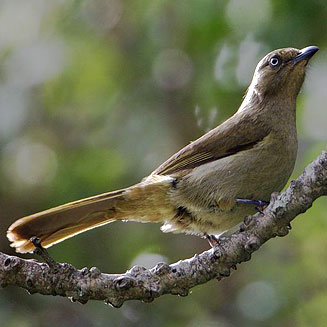 |
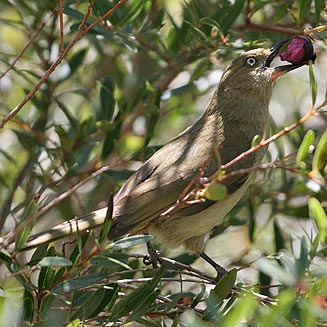 |
|
Sombre bulbul, Wilderness, South Africa. [photo
Trevor Hardaker ©] |
Sombre bulbul, Kirstenbosch Botanical Gardens,
Western Cape, South Africa. [photo David Robertson
©] |
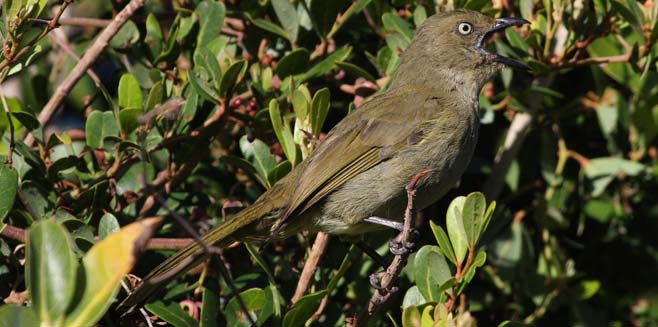 |
|
Sombre bulbul, Tsitsikamma National Park, South
Africa. [photo Duncan Robertson ©] |
Distribution and habitat
Occurs from Kenya through eastern Tanzania and northern
Mozambique to southern Africa. Here it is common across Mozambique, eastern
Zimbabwe, Limpopo Province, Mpumalanga, Swaziland, KwaZulu-Natal, the Eastern
and Western Cape. It generally prefers coastal scrub and forest, or well-wooded
valleys further inland. It also occupies thornveld, dry woodland thickets along
drainage lines in the Karoo and gardens in well-wooded suburbs.
|
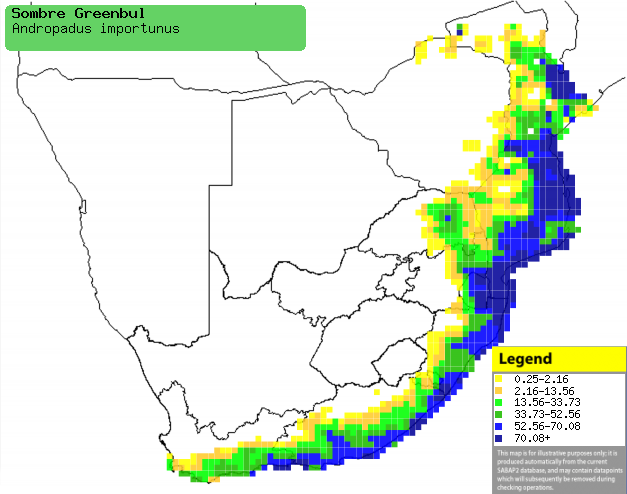 |
|
Distribution of Sombre greenbul in southern
Africa, based on statistical smoothing of the records from first SA Bird
Atlas Project (©
Animal Demography unit, University of
Cape Town; smoothing by Birgit Erni and Francesca Little). Colours range
from dark blue (most common) through to yellow (least common).
See here for the latest distribution
from the SABAP2. |
Brood parasites
It has been recorded as host of the
Jacobin cuckoo.
Food
It eats mainly eats fruit, foraging in the foliage of trees
and bushes, regularly singing its distinctive call. The following food items
have been recorded in its diet:
- Plants
- fruit
- Azima tetracantha (Needle bush)
- Carissa (num-nums)
- Cussonia (cabbage trees)
- Ficus (wild figs)
- Hippobromus pauciflorus (False horsewood)
- Rhus (wild currants)
- Scutia myrtina (Cat-thorn)
- Sideroxylon inerme (White milkwood)
- Viscum (mistletoes)
- Lantana camara (Cherry-pie)
- succulent leaves
- Senecio (a type of creeper)
- Cotyledon orbiculata (Pig's ears)
- flowers and buds of Aloe and Cassia
- nectar of Aloe
- Invertebrates
Breeding
- The nest is built solely by the female, consisting of an open, flimsy cup
built rootlets, twigs, grass and other plant material. It is usually placed
in the fork of or at the end of a tree or bush branch, 1-4 metres above
ground, typically attached with spider web.
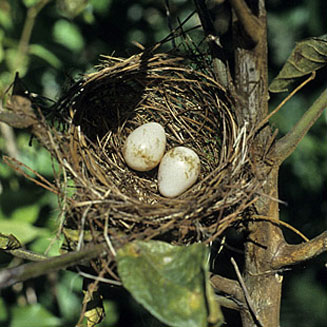 |
|
|
Sombre greenbul nest with eggs, Haroni-Rusitu,
Zimbabwe. [photo Warwick Tarboton ©] |
|
- Egg-laying season is from September-April, peaking from
October-December.
- It lays 1-3 eggs, which are incubated solely by the female for about
12-13.5 days, the male regularly bringing her food. At first it is quite
skittish when disturbed at the nest, but later in the incubation period it
sits tight, not even deserting when touched.
- The chicks are fed and brooded by both adults, leaving the nest after
approximately 10-14 days, becoming independent a few weeks later.
Threats
Not threatened.
References
-
Hockey PAR, Dean WRJ and Ryan PG 2005. Roberts
- Birds of southern Africa, VIIth ed. The Trustees of the John Voelcker
Bird Book Fund, Cape Town.
-
Harrison, J.A., Allan, D.G., Underhill, L.G., Herremans, M.,
Tree. A.J., Parker, V. & Brown, C.J. (eds). 1997. The atlas of southern
African birds. Vol. 2: Passerines. BirdLife South Africa, Johannesburg.
|
